#College of Southern Maryland
Explore tagged Tumblr posts
Text
To protesting students:
SEIZE YOUR CENTURY
Push back against dark times ✊🏼
👏🏼👏🏼👏🏼
#freespeech #righttoprotest #endgenocide
#columbia university#nyu#tufts#massachusetts institute of technology#emerson college#yale university#uc berkeley#arizona state university#cal poly humboldt#ucla#stanford university#university of southern california#university of connecticut#florida state university#university of florida#georgia institute of technology#kennesaw state university#loyola chicago#northwestern university#harvard university#university of maryland#purdue university#indiana university#university of chicago#louisiana state university#university of new hampshire#cornell university#boston university#palestine#palestinians
2 notes
·
View notes
Text
5 Years, 8 Discoveries: NASA Exoplanet Explorer Sees Dancing Stars & a Star-Shredding Black Hole
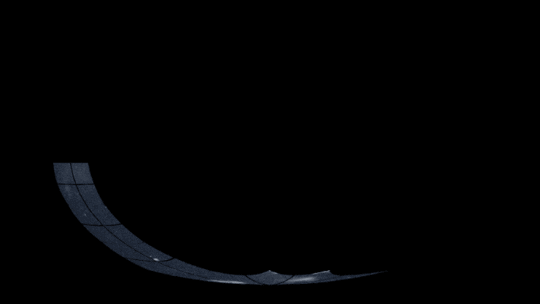
This all-sky mosaic was constructed from 912 Transiting Exoplanet Survey Satellite (TESS) images. Prominent features include the Milky Way, a glowing arc that represents the bright central plane of our galaxy, and the Large and Small Magellanic Clouds – satellite galaxies of our own located, respectively, 160,000 and 200,000 light-years away. In the northern sky, look for the small, oblong shape of the Andromeda galaxy (M 31), the closest big spiral galaxy, located 2.5 million light-years away. The black regions are areas of sky that TESS didn’t image. Credit: NASA/MIT/TESS and Ethan Kruse (University of Maryland College Park)
On April 18, 2018, we launched the Transiting Exoplanet Survey Satellite, better known as TESS. It was designed to search for planets beyond our solar system – exoplanets – and to discover worlds for our James Webb Space Telescope, which launched three years later, to further explore. TESS images sections of sky, one hemisphere at a time. When we put all the images together, we get a great look at Earth’s sky!
In its five years in space, TESS has discovered 326 planets and more than 4,300 planet candidates. Along the way, the spacecraft has observed a plethora of other objects in space, including watching as a black hole devoured a star and seeing six stars dancing in space. Here are some notable results from TESS so far:
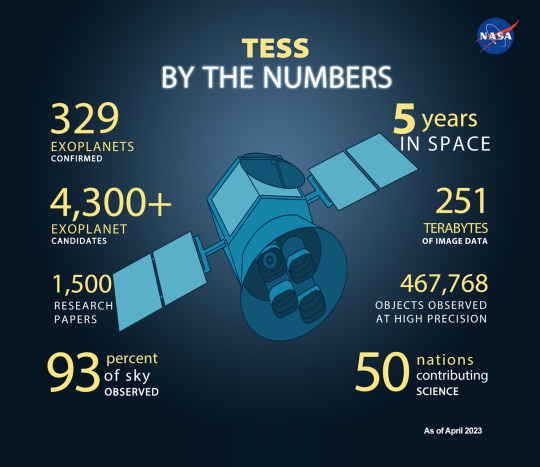
During its first five years in space, our Transiting Exoplanet Survey Satellite has discovered exoplanets and identified worlds that can be further explored by the James Webb Space Telescope. Credit: NASA/JPL-Caltech
1. TESS’ first discovery was a world called Pi Mensae c. It orbits the star Pi Mensae, about 60 light-years away from Earth and visible to the unaided eye in the Southern Hemisphere. This discovery kicked off NASA's new era of planet hunting.
2. Studying planets often helps us learn about stars too! Data from TESS & Spitzer helped scientists detect a planet around the young, flaring star AU Mic, providing a unique way to study how planets form, evolve, and interact with active stars.
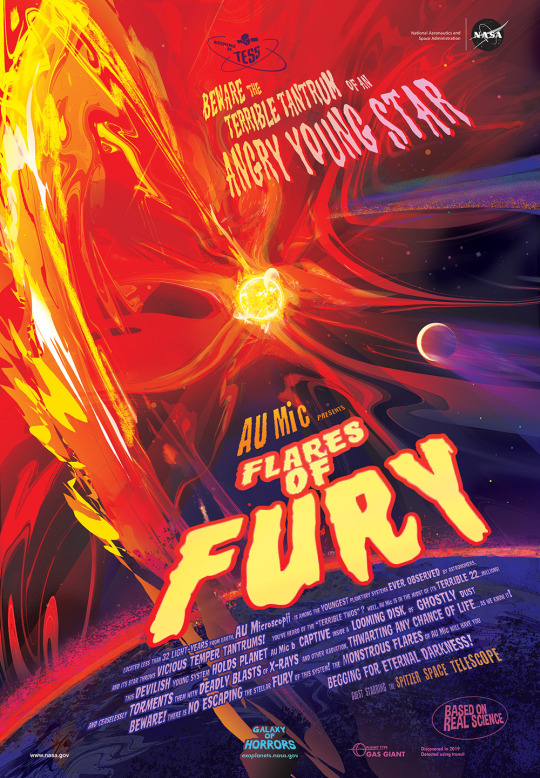

Located less than 32 light-years from Earth, AU Microscopii is among the youngest planetary systems ever observed by astronomers, and its star throws vicious temper tantrums. This devilish young system holds planet AU Mic b captive inside a looming disk of ghostly dust and ceaselessly torments it with deadly blasts of X-rays and other radiation, thwarting any chance of life… as we know it! Beware! There is no escaping the stellar fury of this system. The monstrous flares of AU Mic will have you begging for eternal darkness. Credit: NASA/JPL-Caltech
3. In addition to finding exoplanets on its own, TESS serves as a pathfinder for the James Webb Space Telescope. TESS discovered the rocky world LHS 3844 b, but Webb will tell us more about its composition. Our telescopes, much like our scientists, work together.
4. Though TESS may be a planet-hunter, it also helps us study black holes! In 2019, TESS saw a ‘‘tidal disruption event,’’ otherwise known as a black hole shredding a star.
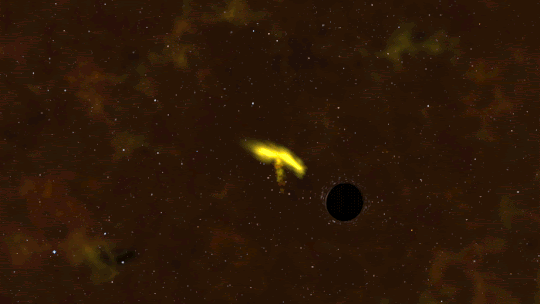
When a star strays too close to a black hole, intense tides break it apart into a stream of gas. The tail of the stream escapes the system, while the rest of it swings back around, surrounding the black hole with a disk of debris. Credit: NASA's Goddard Space Flight Center
5. In 2020, TESS discovered its first Earth-size world in the habitable zone of its star – the distance from a star at which liquid water could exist on a planet’s surface. Earlier this year, a second rocky planet was discovered in the system.
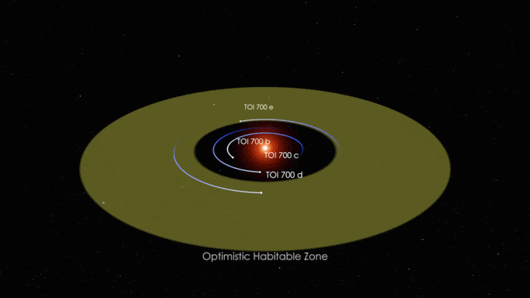
You can see the exoplanets that orbit the star TOI 700 moving within two marked habitable zones, a conservative habitable zone, and an optimistic habitable zone. Planet d orbits within the conservative habitable zone, while planet e moves within an optimistic habitable zone, the range of distances from a star where liquid surface water could be present at some point in a planet’s history. Credit: NASA Goddard Space Flight Center
6. Astronomers used TESS to find a six-star system where all stars undergo eclipses. Three binary pairs orbit each other, and, in turn, the pairs are engaged in an elaborate gravitational dance in a cosmic ballroom 1,900 light-years away in the constellation Eridanus.
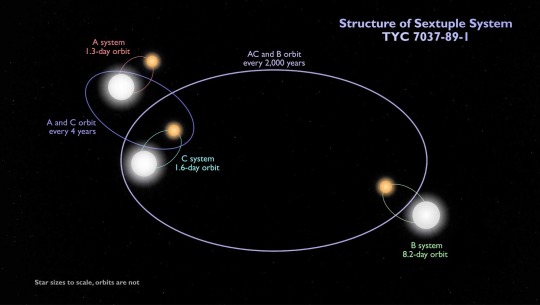
7. Thanks to TESS, we learned that Delta Scuti stars pulse to the beat of their own drummer. Most seem to oscillate randomly, but we now know HD 31901 taps out a beat that merges 55 pulsation patterns.

Sound waves bouncing around inside a star cause it to expand and contract, which results in detectable brightness changes. This animation depicts one type of Delta Scuti pulsation — called a radial mode — that is driven by waves (blue arrows) traveling between the star's core and surface. In reality, a star may pulsate in many different modes, creating complicated patterns that enable scientists to learn about its interior. Credit: NASA’s Goddard Space Flight Center
8. Last is a galaxy that flares like clockwork! With TESS and Swift, astronomers identified the most predictably and frequently flaring active galaxy yet. ASASSN-14ko, which is 570 million light-years away, brightens every 114 days!
Make sure to follow us on Tumblr for your regular dose of space!
#space#planets#exoplanets#science#tech#technology#astronomy#astrophysics#stars#black holes#NASA#spaceblr
2K notes
·
View notes
Text
Fan Labor Offerings
We've had 67 offers for fan labor so far - everything from SPag and cheerleading, to translations in 5 languages, to sensitivity reading for head injuries, to specialist knowledge of camp counseling and US law, to offers for custom AO3 skins and podfic editing - and LOADS more.
Under the cut you'll find the full list, but just as a preview we've got:
Translation in five different languages
Specialists offering their unique knowledge on 15 professions, 15 hobbies, and a variety of medical conditions and subcultures
Sensitivity readers on ten different topics, mainly medical issues and LGBTIA+ topics
Cultural knowledge of eight areas of the US plus seven other countries and two religions
Editing a variety of mediums
Read on for the full list - and stay until the end for some of the more unique offers!
Specialist knowledge offers:
Professional- Academia (US) American legal system/bar exam/practicing law Camp counselor Civil engineering Drafting legislation for local government (American) Employment in movie theaters Forensic science/crime scene investigation/autopsy Funeral services/embalming Medical field expertise: operating room nurse, inpatient/outpatient, emergency and wards Public libraries Small business/environmental/real estate/contracts/and general business law (American) Social media and TV/Film production work Theatre Theme/amusement park (there is a difference!) operations
Medical issues including: Ehler Danlos, surgery, escoliosis, partial disability, poor eyesight, migraines, diabetes, stroke, intellectual disabilities, physical disabilities, and experience with hospitalization
Educational info on charter schools, language immersion education, and US public education
Hobbies- Camping/hiking Chess Choir Classical music, specifically opera Film Geocaching Historical literature Horse care & general equestrian activities Music Musical instruments (guitar, ukulele, handbells) Pet ownership of multiple species/breeds Sewing, tailoring, alterations, fashion history and flat pattern-making Sports culture (US) Textile crafts (esp knitting and mending) Voice and vocal technique
Subcultures including BDSM and leather/kink, Goth, and j-fashion.
Sensitivity reading offers:
ADHD Aromanticism Asexuality Autism Blindness including: accessibility, Braille education, experience with ablism and activism, experience with assistive devices, guide dog use, rehabilitation services, navigating with or without white cane Butch/femme (esp. stone) Genderqueer Head injuries LGBTQ+ Transmasc/non-binary gender identities and/or social/medical/legal gender transitions
Cultural knowledge offers:
Australian American Chinese diaspora British culture/history Catholicism China Columbian culture/Latine culture German culture Judaism Mexican culture United States (Baltimore, Maryland; Illinois; southern California/greater Los Angeles; Great Lakes region; Pacific Nortwest; Upper Midwest; small town/rural college) Taiwan
Translation offers:
Catalan/English French/Catalan French/English German/English Spanish/Catalan Spanish/English Spanish/French Spanish (Latin-American)/English Limited English/Classical Latin
Other fan labor offers:
Typesetting a fic for printing/binding Commenting! Podfic editing Historical research assistance/developing research methodology Book review Custom AO3 workskin Basic AO3 coding Podfic mentoring/tutoring/coaching using Audacity
You guys know So Much. We're so lucky you're all so willing to share!
Want to join us? Sign ups are open until Sunday Feb 2!
86 notes
·
View notes
Text
Public Domain Black History Books
For the day Frederick Douglass celebrated as his birthday (February 14, Douglass Day, and the reason February is Black History Month), here's a selection of historical books by Black authors covering various aspects of Black history (mostly in the US) that you can download For Free, Legally And Easily!
Slave Narratives
This comprised a hugely influential genre of Black writing throughout the 1800s - memoirs of people born (or kidnapped) into slavery, their experiences, and their escapes. These were often published to fuel the abolitionist movement against slavery in the 1820s-1860s and are graphic and uncompromising about the horrors of slavery, the redemptive power of literacy, and the importance of abolitionist support.
Narrative of the Life of Frederick Douglass - 1845 - one of the most iconic autobiographies of the 1800s, covering his early life when he was enslaved in Maryland, and his escape to Massachusetts where he became a leading figure in the abolition movement.
Running a Thousand Miles for Freedom by William and Ellen Craft - 1860 - the memoir of a married couple's escape from slavery in Georgia, to Philadelphia and eventually to England. Ellen Craft was half-white, the child of her enslaver, but she could pass as white, and she posed as her husband William's owner to get them both out of the slave states. Harrowing, tense, and eminently readable - I honestly think Part 1 should be assigned reading in every American high school in the antebellum unit.
Incidents in the Life of a Slave Girl by Harriet Jacobs writing under the name Linda Brent - 1861 - writing specifically to reach white women and arguing for the need for sisterhood and solidarity between white and Black women, Jacobs writes of her childhood in slavery and how terrible it was for women and mothers even under supposedly "nice" masters including supposedly "nice" white women.
Twelve Years a Slave by Solomon Northup - 1853 - Born a free Black man in New York, Northup was kidnapped into slavery as an adult and sold south to Louisiana. This memoir of the brutality he endured was the basis of the 2013 Oscar-winning movie.
Early 1900s Black Life and Philosophy
Slavery is of course not the only aspect of Black history, and writers in the late 1800s and early 1900s had their own concerns, experiences, and perspectives on what it meant to be Black.
Up From Slavery by Booker T. Washington - 1901 - an autobiography of one of the most prominent African-American leaders and educators in the late 1800s/early 1900s, about his experiences both learning and teaching, and the power and importance of equal education. Race relations in the Reconstruction era Southern US are a major concern, and his hope that education and equal dignity could lead to mutual respect has... a long way to go still.
The Souls of Black Folk by W.E.B. Du Bois - 1903 - an iconic work of sociology and advocacy about the African-American experience as a people, class, and community. We read selections from this in Anthropology Theory but I think it should be more widely read than just assigned in college classes.
Darkwater: Voices from Within the Veil by W.E.B. Du Bois - 1920 - collected essays and poems on race, religion, gender, politics, and society.
A Negro Explorer at the North Pole by Matthew Henson - 1908 - Black history doesn't have to be about racism. Matthew Henson was a sailor and explorer and was the longtime companion and expedition partner of Robert Peary. This is his adventure-memoir of the expedition that reached the North Pole. (Though his descriptions of the Indigenous Greenlandic Inuit people are... really paternalistic in uncomfortable ways even when he's trying to be supportive.)
Poetry
Standard Ebooks also compiles poetry collections, and here are some by Black authors.
Langston Hughes - 1920s - probably the most famous poet of the Harlem Renaissance.
James Weldon Johnson - early 1900s through 1920s - tends to be in a more traditionalist style than Hughes, and he preferred the term for the 1920s proliferation of African-American art "the flowering of Negro literature."
Sarah Louisa Forten Purvis - 1830s - a Black abolitionist poet, this is more of a chapbook of her work that was published in newspapers than a full book collection. There are very common early-1800s poetry themes of love, family, religion, and nostalgia, but overwhelmingly her topic was abolition and anti-slavery, appealing to a shared womanhood.
Science Fiction
This is Black history to me - Samuel Delany's first published novel, The Jewels of Aptor, a sci-fi adventure from the early 60s that encapsulates a lot of early 60s thoughts and anxieties. New agey religion, forgotten technology mistaken for magic, psychic powers, nuclear war, post-nuclear society that feels more like a fantasy kingdom than a sci-fi world until they sail for the island that still has all the high tech that no one really knows how to use... it's a quick and entertaining read.
205 notes
·
View notes
Text
🔴Campus protests across the U.S. since April 17
Brown University
California State Polytechnic University
City University of New York
Columbia University
Emerson College
Emory University
Florida International Universit
Florida State University
George Washington University
Harvard University
Indiana University
New York University
Northeastern University
Northwestern University
Ohio State University
Princeton University
Rice University
Texas A&M
Massachusetts Institute of Technology (MIT)
Michigan State University
New School - New York, NY
University of Michigan
Tufts University
University of Arizona
University of California at Berkeley
University of Maryland
University of Miami
University of Minnesota
University of New Mexico, Albuquerque
University of North Carolina at Charlotte
University of North Carolina at Chapel Hill
University of Pittsburgh
University of Rochester
University of Southern California
University of Texas, Austin
University of Texas at Dallas
Vanderbilt University
Yale university

#etats unis#campus#united states#usa#usa news#états unis#palestine will never die#from the river to the sea palestine will be free#genocide in palestine#palestine will be free#free palestine#palestinian resistance#i stand with palestine#palestine#palestine genocide#palestinian genocide#free free palestine#palestinians#pro palestine#stand with palestine#save palestine#support palestine#gaza genocide#gaza under attack#gaza strip#free gaza#gaza under genocide#genocide in gaza#save gaza#gaza
66 notes
·
View notes
Text
Lois Beckett at The Guardian:
California became the fifth state in the US to ban universities from admitting students based on their family connections, and the second state, after Maryland, to extend the ban to private, non-profit universities. “Hard work, good grades and a well-rounded background should earn you a spot in the incoming class – not the size of the check your family can write or who you’re related to,” Phil Ting, the Democratic state assembly member, who authored the legislation, said in a statement. Private non-profit colleges popular with wealthy Americans, including Stanford and the University of Southern California, will be affected by the new legislation, which goes into effect in September 2025. Illinois, Colorado and Virginia have previously passed legislation banning public university admission based on “legacy status”, or connections to donors, according to the National Conference of State Legislators.
The wave of new state laws comes in response to the decision last year by the supreme court’s conservative majority to bar both private and public universities from considering race as a factor in college admissions. The litigation over racially-based “affirmative action” put a spotlight on all the ways that white students benefit from non-racially-coded admissions practices, particularly “legacy” admissions, which media outlets dubbed “affirmative action for rich kids”. The California law will ban admissions offices from “favoring applicants whose family members are graduates of or are significant donors to the school”, which Ting’s office called an “unfair practice often results in a wealthier, less racially diverse student body”.
With the signing of AB1780 into law, California becomes the 5th state to bar legacy admissions in public colleges and the 2nd to do so for all colleges.
#California#Legacy Admissions#Affirmative Action#College#Higher Education#Phil Ting#California AB1780
31 notes
·
View notes
Text
The Scriptures aka towning according to nin. (subject to change)
can’t do this without acknowledging the descriptions of them by @rekikiri which are just perfect plus some more stuff on them here and this wonderful background by @tara-the-star
(I owe everyone like a million socmed posts just for putting up with my shit re: this. enjoy!)
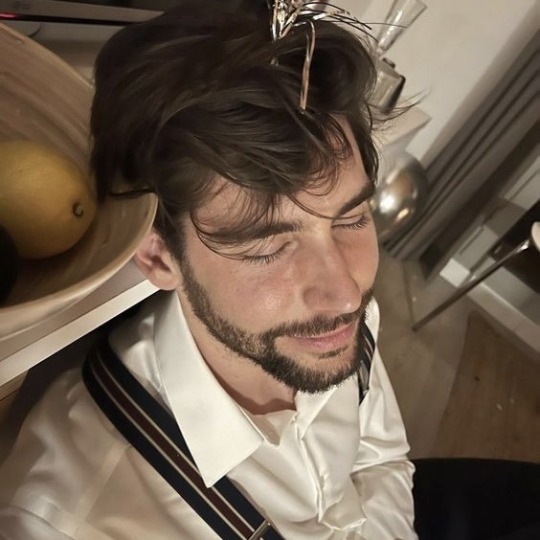

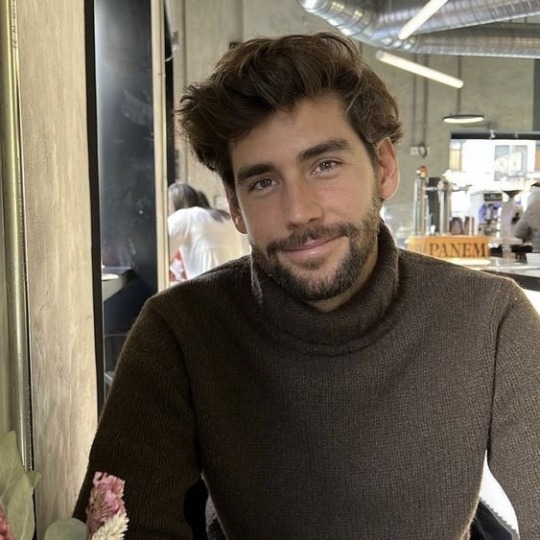
austin michael browning
- southern boy. has a soft southern accent. i was thinking something like southern georgia, but his parents have a stronger accent than he does. he didn't want to be known as the sweet darlin' southern boy when he moved to virginia for his FBI training, so he tried his best to speak a bit more neutral
- it didn't last long
- 6’2, soft brown hair, beautiful brown eyes. he’s covered in freckles and has the most gorgeous warm skin with some terrible tan lines. when he tans, he tans.
- he’s quite built but you can only tell when he takes off his suit jacket or he’s wearing just a shirt/t-shirt. if he could’ve gotten an a+ on the fbi fitness test he would’ve. he’s incredibly strong and goes to the gym most mornings (at like 6am. he’s a real early bird)
- has a bachelors degree in law/criminal justice
- was a detective for two years in georgia until he went to quantico. worked on criminal intelligence cases, but occasionally worked on juvenile crime cases. he had one particularly difficult case involving both departments (organised crime involving a minor) which inspired him to work for the FBI.
- has four siblings. he's the middle child with two older sisters and two younger sisters.
- he’s a somalier without being a somalier. literally knows anything and everything about wine. always has the right bottle of wine for any occasion or meal. recommending wines and opening his favourite wines is his love language.
- his family live by strict traditional values - two of his sisters were married by the time they were 22, and the other two followed suit at 21 and 23. he has a couple of nieces and nephews that he doesn’t get to see too often but he’s their fun uncle. he had a lot of pressure to find a nice girl and settle down, and always brushed off the girlfriend question (he even made up a fake girlfriend when he was in college, just to get his parents off his back) ((they didn’t “date” for very long))
- his dad worked on a farm his whole life and his momma has always been a housewife. his sisters were the only ones his mom taught to cook and clean. he had to teach himself a lot of life skills in college. he still occasionally ruins his clothes by washing them wrong but he’s learned to get his work suits dry cleaned. it’s much cheaper to do that than have to get new ones when he inevitably shrinks them.
- his mom never teaches him how to cook/bake, but she gives him a handwritten book of recipes when he moves to maryland for work. it sits on a shelf in the kitchen of his apartment but he’s never used it
- (until towns visits his apartment for the first time and tells him that he has to make him some of his ‘momma’s recipes’ someday. browning falls in love, naturally, and tries a couple dishes and treats)
- he didn’t really know or acknowledge that he was gay until he was in college. he’d had a few “girlfriends” here and there in highschool but he always felt like he was forcing himself into liking them. he kissed a boy for the first time when he was 19, and everything made sense for him, but even still he buried it down quite deep and focused on his studies instead of relationships.
- his family are not accepting at all. He grew up around a lot of homophobia and slurs and disrespect of lgbt+ people, and so that made it really hard for him to come to terms with his sexuality. he started to distance himself from them when he went to college, and the weekly phone calls with his mom turned to once a fortnight, into once or twice a month, into whenever she eventually didn’t take no for an answer and kept calling until he picked up.
- the only person who knew that he was gay was his oldest sister, who he came out to when he was in the third year of his degree. she was honest and told him that their mom and dad wouldn’t be supportive of him, but she wasn’t going to tell them either.
- she always changed the topic when the “girlfriend” conversation came up when he would go home for thanksgiving or Christmas or some other occasion. he appreciated that a lot
- started smoking cigarettes in college and struggled to give it up. he barely smokes anymore but every now and again on a tough case he finds himself reaching for a packet of cigarettes (towns hates it)
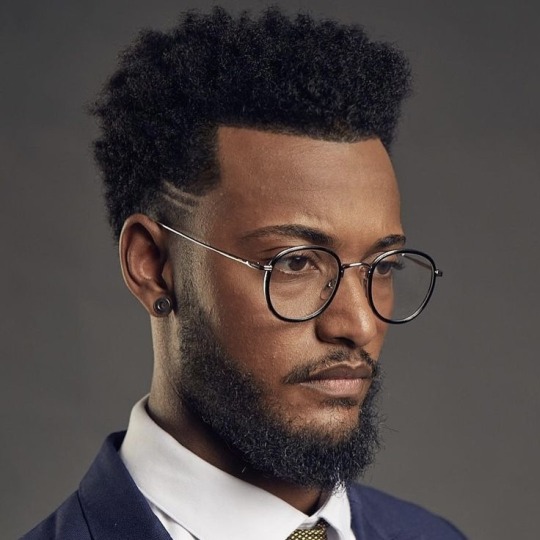
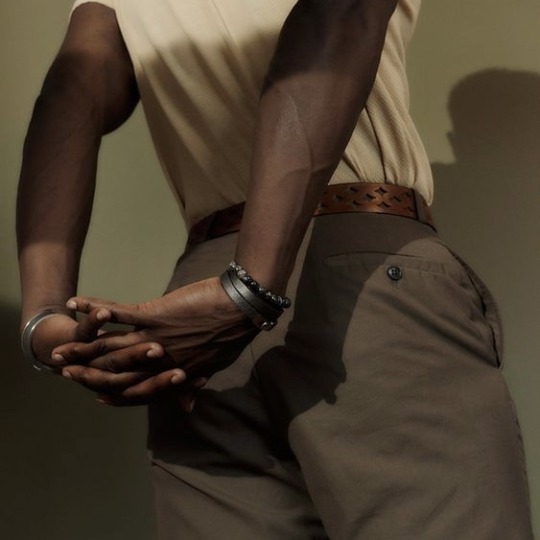

samuel arthur towns
- new york new yooorkkk. he was born somewhere in new york that i haven't figured out yet.
- 5’11, mixed with a white dad and a black mom. he wears glasses. he’s not as big or strong as austin is, but he’s in really good shape. he has gorgeous dark brown eyes and spends way too much time on his hair.
- has a tattoo on his thigh.
- he’s an only child to his absolutely amazing mother and father. they’re SO supportive of him and have always trusted him to make good choices in life - he tells his mom everything. he calls her almost every other day and visits home as often as possible.
- has a double bachelors degree in psychology and law from Columbia
- was a backliner on his high school exy team but never had any intentions of becoming an athlete/going pro. he was a TOTAL jock back then
- when he graduated college he pretty quickly knew he wanted to do something good that wasn’t necessarily becoming a cop. he waited until he turned 23 and on the day he finished his two years of working in an attorney’s office, he applied for a job with the fbi
- came out as gay pretty young. his parents have always been fairly liberal (his mom was a hippie back in the day) so he came out as a teenager and they’ve always been cool with it
- right when he was in the middle of his FBI training in quantico, he was dumped by the man he’d been dating for like two years. he had to put it to the back of his mind to focus on the academy, but it was one of the things that made him and austin first start speaking
- he’s kept journals since he was a kid. he has a full shelf of journals and sketchbooks from the age he was 10 or 11 until the present. he always carries a little black notebook with him and writes down his thoughts and little sketches. (its full of doodles of browning)
- his parents also have books and boxes full of photos of him from birth. it’s like an INSANE number of photos. their attic is just full of boxes and boxes of pictures. (austin’s favourite is one they have on the wall in the living room of sammy as a teenager in his exy gear)
- in turn he’s really into photography too and always takes photos. he shoots on film, so he has loads of boxes full of photos too. his dream is to have a dark room in his home.
- his mom really is his best friend. she’s his biggest fan, and the reason he studied psychology. she’s a holistic therapist, and gives the BEST advice. his dad is a food critic.
- when he was younger a friend of his was killed after because he became involved with the wrong people and ended up in a gang. it totally changed a lot for him, and seeing the way the case was handled really inspired him to get into law/want to go into the fbi. he saw all these young black boys from underfunded and underprivileged backgrounds finding themselves caught up in gangs and when things would happen to them - it was clear the effort to stop the feuds and the violence was not as important as if a young white man had been killed, or indoctrinated because he had no choice.
- his mom was worried when he told her that he’d applied to be in the fbi. they had a very long conversation about the realities of what he would see working with the fbi, why he wanted to do it, what it would mean for his future, and the things he couldn’t do. he knew all of it already, having researched it all as soon as he realised it was the career path he wanted to go down, but she really wanted to be sure he knew what he was getting himself into. it scared him, for a little bit, but he knew it was the right choice for him.
- he has a license, but doesn’t drive that much. he didn’t really need to drive much living in new york, and 90% of the time, in maryland, austin drives him around.
- he’s partially deaf in one ear from a crash that happened during a car chase a few years into working with the fbi.
- the hardest part about working where he does was learning how to shoot a gun. he hates it. like he’s good at it and smart with it but he hates having a gun. the first time he shot a real person he held it together until he got home later and was practically in shock. (he wasn’t sure if telling his mom broke confidentiality or not, so because he was on the case with austin, he invited him over and he ended up staying the night just to keep him company)
- austin and sam only lived in seperate apartments for about six months when they moved to maryland until they decided to move in together. austin was already renting a two bedroom apartment, whereas sam was in a studio, and it just made more financial sense for them to move in together. ("financial")
- he started crushing on austin so early on in their friendship, but he had no idea that austin was pretty much the same.


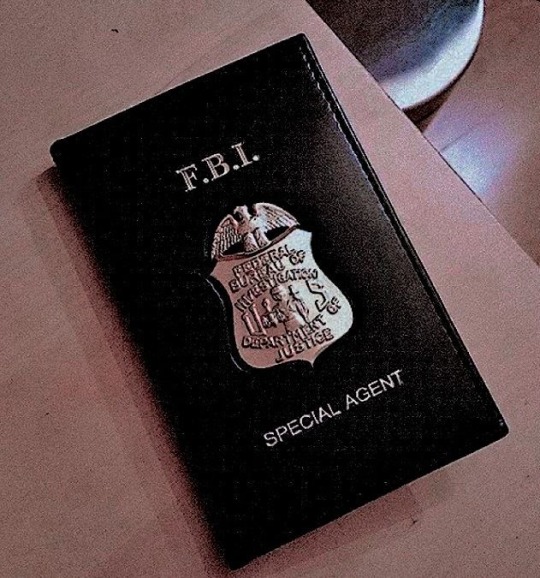
- austin and sam met when they both started their training in quantico together. they were roommates at the academy but didn’t really interact too much. they only really started talking after one of the first weekends they were allowed to leave the campus - towns went home to visit his boyfriend on the Friday and came back trying to hide the fact he was a wreck on Sunday. he tried not to talk about it, because they’re judging their emotional maturity in the academy, but when browning asked if he was okay, he spilled a little too much.
- even after that, they weren’t really friends. they talked, of course, about their classes and the academy itself, but that was mostly it. towns didn’t know browning was gay, because he never mentioned it, even when towns told him he was gay. most evenings austin would sit at his desk with headphones on while studying, and sammy wouldn’t usually interrupt.
- then one time when they’re both at the gym at the same time, austin notices sam working out, and his form isn’t quite right for the work out he’s doing. austin corrects him after telling him he’ll hurt himself working out the way that he is, and he helps him through a couple of other sets that he does himself. they go to the gym together most days after that, spotting each other when they’re doing weights. they start running in the mornings, too.
- during the course of training there’s a couple of occasions where students at the academy are expected to wear business attire. they’re both getting dressed up in their suits, and austin is kind of embarrassed because he doesn’t really know how to properly tie a tie. his dad usually tied them for him, and for some reason even though he swore he knew how to do it, he’s just really struggling. sam offers to help and austin ends up talking a little bit about his family, but not giving away anything about how shitty they really are.
- one of the weekends they’re allowed off campus, later on at their time in training, towns asks browning if he wants to go out for dinner and a drink. it’s not a date, and neither of them think it is, but neither of them were going home for the weekend and they both wanted to do something. austin ends up picking a restaurant based off their wine list, and they talk about their lives outside of quantico for a little bit. they can’t exactly go out and get drunk - or they’re both afraid to do so in case they get kicked out of the academy - but they sit and talk and share a bottle of wine.
- they get closer, and when they graduate, towns’ mom and dad show up, and browning’s family doesn’t. they take pictures together (one of towns’ favourite photos ever) and sam introduces austin to his mom and dad. they’re going out for a celebratory meal, and sam’s dad invites austin along so he’s not celebrating by himself. he refuses, but when they insist, he comes along.
- oh and it’s SUCH a nice evening. he fills any rare awkward silence by explaining his wine choice to sammy’s dad, while sam’s mom nudges her son and raises her eyebrows like oh, he’s cute.
- they exchange phone numbers before they both head home to wait for their offers.
- (austin spent most of those 18 weeks smiling because of how close him and sam got. sam spent about half of that time thinking damn. am I falling for another straight guy?)
- austin calls sam first the day they find out where they’re being stationed. they tell each other on 3 that they’ve both been stationed in maryland and oh my god. Austin didn’t even know he was going to feel so relieved but he’s like holy shit. I didn’t even realise i was secretly really hoping that we were going to work together.
(there’s more but. I have to stop myself. The brain rot is setting in deeper and deeper)
#SUBJECT TO CHANGE CAPITAL LETTERS#posting this and running away#this is just a brain dump for now#most of this is kind of silly#but#validate me and tell me this is fun and not annoying as hell lmao#because these guys.#they’re like my new ocs okay#and also#look the face cast for towning is a famous guy#so if you know him no you don’t because that’s simply austin towning thanks#this will NOT be a repeat of the hockey guy situation#towning#mine
43 notes
·
View notes
Text




Leeah Joo
Leeah Joo is a Korean-American painter based in Connecticut. Born in 1971 in Seoul, Leeah was raised by a sculptor father and an illustrator mother. At age ten, her family moved to Indianapolis, where she spent her youth. She studied painting and art history at Indiana University in Bloomington and received her MFA in painting from Yale School of Art. Her paintings have exhibited widely in U.S. and South Korea and recognized with awards from Pollock Krasner, George Sugarman Foundation and Connecticut Commission on Arts. Since 1996, she has taught and served as visiting artist at many institutions including the Kansas City Art Institute, Maryland Institute College of Art, Hartford Art School and Fairfield University. She lives and paints in Middlebury and teaches at Southern CT State University.
9 notes
·
View notes
Text
youtube
since people here generally don't do sports I thought I would share the college football meme of the season with you
[video description: two views of an American football play. there are ten seconds left in the half. University of Maryland is on offense and University of Southern California on defense.]
Announcer, before the play starts: Oh my goodness, don't get too crazy, Maryland. They're not going to clock it? (translation: choose not to run an actual play because they won't be able to score before halftime)
[the Maryland center snaps the ball right through the quarterback's hands, sending it into the backfield to eventually be recovered by the other team]
Announcer, screaming himself ragged in a rather startling way: OH NO! DISASTER! WHAT A BAD IDEA!!!
#football#maryland#usc#disaster#see because it's the half it doesn't really *matter*#but the call is fantastic#Youtube
12 notes
·
View notes
Text
𝑨𝒔 𝒊𝒔 𝒕𝒓𝒂𝒅𝒊𝒕𝒊𝒐𝒏 Harry and Meghan were 𝑵𝑶𝑻 amongst the lineup of celebrity commencement speakers this year by u/SeptiemeSens
🎓𝑨𝒔 𝒊𝒔 𝒕𝒓𝒂𝒅𝒊𝒕𝒊𝒐𝒏, Harry and Meghan were *𝑵𝑶𝑻* amongst the lineup of celebrity commencement speakers this year 🎓 Dear Sinners,Another graduation season has come and gone 🎓 And once again, the Duke and Duchess of Sussex were missing from the lineup of notable 2024 commencement speakers. If I remember correctly, the only so-called "graduation speech" Meghan has given was this bizarre unsolicited "graduation speech" she released to the media in 2020 👀Here's a list of some of H&M's "famous friends" who have given commencement speeches over the years. These are individuals who have participated in ARO, Archetypes, and/or 40x40:📌ARO:John Legend (singer, songwriter, producer, EGOT winner) - Loyola Marymount University, 2024. John has given many commencement speeches over the years and is also the recipient of three (3) honorary doctorate degrees as well. His wife and ARO jam recipient, Chrissy Teigen however, has not given any commencement speeches nor received any honorary degreesMindy Kaling (actress & comedian) - Dartmouth University, 2018Tracee Ellis Ross (actress, daughter of Diana Ross) - Spelman College, 2023source 1 // source 2📌Archetypes podcast guests:Mindy Kaling (actress & comedian) - Dartmouth University, 2018Mellody Hobson (President and co-CEO of $14.9B Ariel Investments, Chairwoman of Starbucks Corporation, wife of George Lucas) - University of Southern California, 2015Serena Williams 🏆- Graduating Class of 2020Trevor Noah (S. African comedian) - Princeton University, 2021source)📌 40x40 Participants:Deepak Chopra (author and alternative medicine advocate) - University of Southern California, 2017Hillary Clinton (politician, wife of former US President Bill Clinton) - At age 21, Hillary famous delivered her Wellesley 1969 commencement speech. She returned to her alma mater in 2017 to deliver another commencement speechKatie Couric (journalist) - UMass Medical School, 2017 most recently. Katie has given many commencement speeches over the yearsKerry Washington (actress) - George Washington University, 2013. Kerry also received an honorary Doctorate degreesource 1 // source 2 // source 3📌 Friends:Ellen DeGeneres - Tulane University, 2009Gayle King - University of Maryland, 2023Gloria Steinem - M's bestie "Glo" has given many commencement speeches over the decades. Perhaps her most famous was at Tufts University, 1987Oprah Winfrey - Oprah has given dozens of commencement speeches and has also received numerous honorary degrees over the decades📌 Bonus:Actress Kathryn Hahn - As an interesting comparison to Meghan: Kathryn is an respected and accomplished actress, you may recognize her from Parks & Recreation, WandaVision, and Spiderman: Into The Spiderverse (IMDb). TIL that like Meghan, Kathryn is a Northwestern alumni. This year, Kathryn gave the commencement speech at Northwestern University. Northwestern also gave Kathryn, along with three other accomplished alumni [*not* named Meghan Markle], honorary Doctor of Arts degrees👉 Why hasn't Northwestern invited Meghan Markle to give a commencement speech?👉 Why hasn't Northwestern given Meghan Markle an honorary degree? 📌 Notes:In 2020, H&M signed with the esteemed NY-based Harry Walker Agency. Here is Meghan, The Duchess of Sussex's profile page. (I could not find a profile page for Harry.) This is the same high powered agency that also represents the Clintons, the Obamas, John Legend, and many others for speaking engagements. At the time, it was widely reported that H&M could charge up to $1M per speech!🤑 Where did all of H&M's dream$ of making million$ of dollar$ by giving word $alad $peeche$ go? 🤑 post link: https://ift.tt/PytGmjV author: SeptiemeSens submitted: July 03, 2024 at 02:35PM via SaintMeghanMarkle on Reddit disclaimer: all views + opinions expressed by the author of this post, as well as any comments and reblogs, are solely the author's own; they do not necessarily reflect the views of the administrator of this Tumblr blog. For entertainment only.
#SaintMeghanMarkle#harry and meghan#meghan markle#prince harry#fucking grifters#grifters gonna grift#Worldwide Privacy Tour#Instagram loving bitch wife#duchess of delinquency#walmart wallis#markled#archewell#archewell foundation#megxit#duke and duchess of sussex#duke of sussex#duchess of sussex#doria ragland#rent a royal#sentebale#clevr blends#lemonada media#archetypes with meghan#invictus#invictus games#Sussex#WAAAGH#american riviera orchard#SeptiemeSens
14 notes
·
View notes
Text
RAPID-FIRE QUICK OPINIONS OF CITIES I'VE BEEN TO IN RECENT HISTORY
Rochester, New York (and other upstate NY cities in general) : Feels generic, but perhaps not necessarily in a bad way in this case. A resident said it's rare to see and live a place where kids still play in the front yard these days, so take as you will. New York, New York: What you'd expect these days. Allentown, Pennsylvania: Lots of industrial traffic as you'd expect, but cute town and good people. I made multiple and different kinds of friends here, which I consider very good for this sort of thing. Philadelphia, Pennsylvania: Homey. Don't go too far west, though or you'll run into Pennsylvanians. Remember James Carville! Baltimore, Maryland: Cutesy, gives vibes of home. Funny to see products from businesses by people I grew up with in places there. Washington, DC: It really does try to be a commercial with everyone perfectly chosen from central casting. Bad vibes, avoid, avoid. Get out if you live there. Imperial capital though, what does one expect. Norfolk, Virginia: Military city as you'd expect, and by far the most "Southern" feeling city in this list. Interesting contrast between the attempted beachiness and the dominating military stuff. St. Augustine, Florida: The best city in Florida by far, but losing its soul over the years and I'm very worried. Flagler College students will be window dressing for the upscale middle-aged tourists coming there. Tampa, Florida: Genuinely horrible. Worst city on this list, one huge slum posing as a 'regular' city. Unfriendly people. Telling every other billboard is for a lawyer promising to get you big money. Bad sign of the future. Orlando, Florida: Better than Tampa I suppose, but leaning way too hard into being Red State America's family vacation Mecca, which will lead to issues for it in the future. This city isn't for me. Denver, Colorado: People there like me, at least one person recognized my face from before, and mountains are cool. Las Vegas, Nevada: Very middlebrow, which I don't say as a compliment. Seeing middle aged people in cosplay out in public in non-convention contexts was embarrassing. Only interesting bit was seeing where Balrog's Street Fighter II stage was IRL. Reykjavik, Iceland: Neat place. Felt like the USA but cold and barren, of course. Icelandics are a unique people, and a small part of me almost wants to classify Iceland with North America than Europe since the society just feels different from regular Europe. I always thought it was worth noting the tectonic plate cleaves through the island. London, England: Honest with itself in that it's big, very big, and touristy too, which for said honesty reasons I respect it. I liked it. British people really are the Americans of Europe. I shouldn't, but I like the UK. I will visit the midlands soon, so I hope to see a fun contrast. Brussels, Belgium: Also an honest city, in this case in that it's a transnational confederal capital for a lot of places. Mons, Belgium: Lovely. Friendly and great people. Taking the train to it and seeing the scenes of rural life reminded me of the countryside I'd see back home. Paris, France: Genuinely lovely, and my favorite city of this list. More cities should be like Paris. I didn't see or deal with any of the bad stuff I heard about it. Friendly people. I need to go back here. Frankfurt, Germany: Definitely generic. Lisbon, Portugal: Touristy because it's warm and honest with itself about it in that case, which is also fine. I like warm weather so I liked Lisbon. Warsaw, Poland: Likable. Quite a nice city, and Poles are a very welcoming people. (Be proud of your country, @aomitois.) A friendliness emanated from the city which I liked. Has an optimism which I find intriguing. Budapest, Hungary: Strangely, I was reminded most of Salisbury, Maryland with this one: there was an odd familiarity driving and walking through the city. Like with Warsaw, it's legitimately trying hard, but that makes sense for Eastern Europe in this era.
I'm sure there's more cities that can go on here, probably a lot more, but this is off the top of my head and the entry is big enough as is. COMING SOON: The Middle East and East Asia! Maybe Latin America. Africa is more likely than Australia. Watch as I wind up in Antarctica for some dumb reason.
7 notes
·
View notes
Text



NASA Takes to the Air to Study Wildflowers
For many plant species, flowering is biologically synced with the seasons. Scientists are clocking blooms to understand our ever-changing planet.
NASA research is revealing there’s more to flowers than meets the human eye. A recent analysis of wildflowers in California shows how aircraft- and space-based instruments can use color to track seasonal flower cycles. The results suggest a potential new tool for farmers and natural-resource managers who rely on flowering plants.
In their study, the scientists surveyed thousands of acres of nature preserve using a technology built by NASA’s Jet Propulsion Laboratory in Southern California. The instrument — an imaging spectrometer — mapped the landscape in hundreds of wavelengths of light, capturing flowers as they blossomed and aged over the course of months.
It was the first time the instrument had been deployed to track vegetation steadily through the growing season, making this a “first-of-a-kind study,” said David Schimel, a research scientist at JPL.
For many plant species from crops to cacti, flowering is timed to seasonal swings in temperature, daylight, and precipitation. Scientists are taking a closer look at the relationship between plant life and seasons — known as vegetation phenology — to understand how rising temperatures and changing rainfall patterns may be impacting ecosystems.
Typically, wildflower surveys rely on boots-on-the-ground observations and tools such as time-lapse photography. But these approaches cannot capture broader changes that may be happening in different ecosystems around the globe, said lead author Yoseline Angel, a scientist at the University of Maryland-College Park and NASA’s Goddard Space Flight Center in Greenbelt, Maryland.
“One challenge is that compared to leaves or other parts of a plant, flowers can be pretty ephemeral,” she said. “They may last only a few weeks.”
To track blooms on a large scale, Angel and other NASA scientists are looking to one of the signature qualities of flowers: color.
Mapping Native Shrubs
Flower pigments fall into three major groups: carotenoids and betalains (associated with yellow, orange, and red colors), and anthocyanins (responsible for many deep reds, violets, and blues). The different chemical structures of the pigments reflect and absorb light in unique patterns.
Spectrometers allow scientists to analyze the patterns and catalog plant species by their chemical “fingerprint.” As all molecules reflect and absorb a unique pattern of light, spectrometers can identify a wide range of biological substances, minerals, and gases.
Handheld devices are used to analyze samples in the field or lab. To survey moons and planets, including Earth, NASA has developed increasingly powerful imaging spectrometers over the past 45 years.
One such instrument is called AVIRIS-NG (short for Airborne Visible/InfraRed Imaging Spectrometer-Next Generation), which was built by JPL to fly on aircraft. In 2022 it was used in a large ecology field campaign to survey vegetation in the Jack and Laura Dangermond Preserve and the Sedgwick Reserve, both in Santa Barbara County. Among the plants observed were two native shrub species — Coreopsis gigantea and Artemisia californica — from February to June.
The scientists developed a method to tease out the spectral fingerprint of the flowers from other landscape features that crowded their image pixels. In fact, they were able to capture 97% of the subtle spectral differences among flowers, leaves, and background cover (soil and shadows) and identify different flowering stages with 80% certainty.
Predicting Superblooms
The results open the door to more air- and space-based studies of flowering plants, which represent about 90% of all plant species on land. One of the ultimate goals, Angel said, would be to support farmers and natural resource managers who depend on these species along with insects and other pollinators in their midst. Fruit, nuts, many medicines, and cotton are a few of the commodities produced from flowering plants.
Angel is working with new data collected by AVIRIS’ sister spectrometer that orbits on the International Space Station. Called EMIT (Earth Surface Mineral Dust Source Investigation), it was designed to map minerals around Earth’s arid regions. Combining its data with other environmental observations could help scientists study superblooms, a phenomenon where vast patches of desert flowers bloom after heavy rains.
One of the delights of researching flowers, Angel said, is the enthusiasm from citizen scientists. “I have social media alerts on my phone,” she added, noting one way she stays on top of wildflower activity around the world.
The wildflower study was supported as part of the Surface Biology and Geology High-Frequency Time Series (SHIFT) campaign. An airborne and field research effort, SHIFT was jointly led by the Nature Conservancy, the University of California, Santa Barbara, and JPL. Caltech, in Pasadena, manages JPL for NASA.
The AVIRIS instrument was originally developed through funding from NASA’s Earth Science Technology Office.
TOP IMAGE: In this illustration, an imaging spectrometer aboard a research plane measures sunlight reflecting off California coastal scrub. In the data cube below, the top panel shows the true-color view of the area. Lower panels depict the spectral fingerprint for every point in the image, capturing the visible range of light (blue, green, and red wavelengths) to the near-infrared (NIR) and beyond. Spatial resolution is around 16 feet (5 meters). Credit: NASA
CENTRE IMAGE: NASA’s AVIRIS sensors have been used to study wildfires, World Trade Center wreckage, and critical minerals, among numerous airborne missions over the years. AVIRIS-3 is seen here on a field campaign in Panama, where it helped analyze vegetation in ma… Credit: NASA/Shawn Serbin
LOWER IMAGE:Researcher Ann Raiho measures sunlight interacting with yellow Coreopsis gigantea flowers during field work in the Jack and Laura Dangermond Preserve in California’s Santa Barbara County in 2022. Credit: NASA/Yoseline Angel
2 notes
·
View notes
Text

Jace Underwood
PART 1: THE BASICS
What is your full name? Jace Mykeal Underwood
Where and when were you born? Born in Maryland on March 9, 1994
Who are/were your parents? (Know their names, occupations, personalities, etc.) Mother names was Aurelia Riggs, but married and dropped Riggs to be Aurelia Underwood. Father name is Blake Underwood.
Do you have any siblings? What are/were they like? Sister, Bailey Underwood. To him, he’s super proud of her and all she’s accomplished. He thinks she’s hardworking, caring, and nurturing. They look out for each other.
Where do you live now, and with whom? Describe the place and the person/people. Jace lives alone in a townhome now. It’s decorated with the help of his sister, but not anything over the top. Lots of white, red and black in his home.
What is your occupation? Jace is a civil engineer who specializes in disaster management. His main job is to ensure that different structures throughout the city are prepared to withstand natural disasters, assess the risk posed to specific communities, and also to help lead rebuilding efforts. He works for FEMA. Due to his degree, he also is able to pick up side contracting gigs and do work to inspect homes in preparation for sale/purchase.
Write a full physical description of yourself. You might want to consider factors such as: height, weight, race, hair and eye color, style of dress, and any tattoos, scars, or distinguishing marks. He's tall with a semi-athletic build, he works an active career so its not hard to stay slim. He weighs about 200 and is 6'2. He enjoys tattoos with two full arm sleeves, connected by a chest piece. He also has tattoos covering his stomach, and legs. His hair is almost always covered by a hat of some sort and his locs reach his shoulders, but are constantly growing. He has brown eyes. He likes to dress comfortably, he's not fancy by any means. Fancy to him is throwing on a designer version of the atheltic wear he is typically donning. A lot of his clothes are black, gray, and white, but he does have a ridiculous shoe collection that he will utilize to pull in a random pop of color. His preferred uniform? Sweats, a hat to match, and white t-shirt, maybe a hoodie/zipup to match the sweats if its a little chilly out. His favorite shoe is the Jordan 1.
To which social class do you belong? Jace is a solid upper middle class citizen. He earns a six-figure salary at his full-time job and does enjoy doing that work. Jace has the ability to make additional money through side hustles (home inspections, commercial real estate inspection) but he hasn't pursued that as his main line of work for his own personal reasons (benefits, time off, etc.).
Do you have any allergies, diseases, or other physical weaknesses? Jace doesn't have any known food allergies, but has really bad seasonal allergies. Its one of the reasons he enjoys LA, because they don't flare up as bad as they did when he was a kid. They are triggered by the fires though as the smoke in the air has significant impacts on air quality and his ability to breathe.
Are you right- or left-handed? He's left handed.
What does your voice sound like? His voice is deep. It's strangely southern, but not indecipherable. Most of it is due to the people he hung around in college and adopting their slang. When he's upset, his native DMV accent will come through, but generally his accent is neutral.
What words and/or phrases do you use very frequently? "Nah" "type shit" "Bet" "yo"
What do you have in your pockets? Keys, vaseline, phone, pack of gum. & if its the weekend, he probably got a gun in his waist band.
Do you have any quirks, strange mannerisms, annoying habits, or other defining characteristics? When he's stressed, he wipes his hands over his face. He also tends to play with the tips of his hair when he's deeply focused in a conversation. His face is naturally deadpan, which might make some people think he's a lot more unapproachable than he actually is.
PART 2: GROWING UP
How would you describe your childhood in general? Jace generally had a happy childhood. He was a true little boy, grass stains in the jeans, frequently doing little daredevil stunts on the playground and always wanting to be outside. He was forced into being a more responsible, and mature kid at about 6 when his parents had their second child.
What is your earliest memory? Jace's earliest memory is getting ice cream with his grandfather before watching football games on the weekends. His grandfather would often watch him so that his parents got down time, but he loved those times.
How much schooling have you had? Jace has earned his bachelor's degree in civil engineering.
Did you enjoy school? Jace grew up in a pretty high structured home environment, so while he didn't love the academic aspect of school, he did what he had to do to get scholarships and graduate on time.
Where did you learn most of your skills and other abilities? He learned most of his skills from his dad. His dad taught him in many ways how to be a man and taught him alot about materials used to build things, it was just something the two of them were always talking about. Jace would be marvelled at the architecture of buildings and bridges in DC and his dad would go into depth about how they were built and sustained. His dad also taught him the simple things like how to cook for himself (even though his mom was the true chef of the family) and how to clean up after himself as a man.
While growing up, did you have any role models? If so, describe them. Growing up his father was his role model until he wasn't. Jace admired his dad for being the head of his family, but when he learned that his dad had been cheating on his mother for much of his life, it shattered the image he had of him. It was then that Jace began to idolize his mother for both her physical and mental/emotional strength. She was the glue to keep their family together.
While growing up, how did you get along with the other members of your family?
As a child, what did you want to be when you grew up? Jace wanted to be G.I. Joe when he grew up. He literally just wanted to be super strong and be able to save the world from bad guys. He got lucky falling into the work that he did, because he literally graduated high school with no plan besides to follow the money, which happened to be at CalTech. He didn't know what he was going to do with his degree, which partially explains the brief but impactful crashout period he had right after finishing college.
As a child, what were your favorite activities? His favorite thing to do as a kid was try to turn his little sister into a little brother, play outside with bikes, and go to the park. He also enjoyed getting to spend time with his grandparents.
As a child, what kinds of personality traits did you display? As a kid he was adventourous, goofy, friendly, and energetic.
As a child, were you popular? Who were your friends, and what were they like? He was a well-liked kid, but popular is a reach. He didn't become popular until high school. He had a close friend named Neal in elementary school, and he also had Pop Warner Track and Field teammates who he hung out with and were always invited to his childhood birthday parties.
When and with whom was your first kiss? His first kiss was in third grade with a girl named Mariah. It was nothing eventful, they kissed behind a tree at recess and she was his girlfriend for the rest of that day.
Are you a virgin? If not, when and with whom did you lose your virginity? He lost his virginity in high school to a girl named Miko. He really liked her and they were a real puppy love couple, but once Jace lost his virginity, he turned into a whore. Poor Miko, he broke that girls heart because for the rest of high school he really was for everybody.
PART 3: PAST INFLUENCES
What do you consider the most important event of your life so far? His mother's funeral because it changed his brain chemistry and who he was. He became a bit colder after that, and a bit more reckless. He has since matured but that event made him really lose touch with reality for a while.
Who has had the most influence on you? His mother and sister have the greatest influence on him. He will do anything for their favor.
What do you consider your greatest achievement? Jace’s greatest achievement was purchasing his home.
What is your greatest regret? He feels pretty bad about how he treated the girl he lost his virginity to. That girl did not deserve to get played like that.
What is the most evil thing you have ever done? The most evil thing he's ever done is pistol whip someone because he lost a street race. He split the gentleman's brow open and broke his jaw. He got away with the crime, but it took him a while to sleep peacefully afterwards without thinking someone was out for their getback.
Do you have a criminal record of any kind? Jace has been arrested a few times for reckless driving and violating gun laws. He's been licensed to carry but has gotten caught up a few times with where he's had his gun and the circumstance with which he got caught in. He's never spent more than 2 weeks in jail and his record was clear enough to get him a job with FEMA. They still on his ass about them charges though...
When was the time you were the most frightened? Jace was most frightened the first time he pulled a gun on someone. He had no intentions of using it, but he pulled to regain control of a situation. His fear was that he was going to have to kill someone because they called his bluff. Fortunately, that did not happen.
What is the most embarrassing thing ever to happen to you? The most embarrassing thing that ever happened to Jace was when he got his ass beat by one of his ex-girlfriends old (but not old) boyfriends. Jace had fallen in love with the girl, but she was a little quicker than him when it came to the love game. He called himself fighting for her love and got his ass beat by somebody he should've never tried to fight to begin with.
If you could change one thing from your past, what would it be, and why? Jace would wish that his parents never split up. It started a nasty spiral of him feeling like nothing was real in the world and made him really resent his father. He would change the fact that his father was a cheater so that his mom never felt the need to end their marriage and he thinks that would've fixed all the problems he had later in life.
What is your best memory?Jace's best memory is one of the times he went to Disney World with his family as a kid. He was 11 at the time and he just remembered how happy everyone was. He got to take his younger sister on a lot of the rides, and be his definition of a good big brother. His mom and dad were also genuinely happy, and it was a weekend filled with a lot of love and laughter in his family. They also stayed on the resort, so it felt like an extra magical weekend. Only the closest people to Jace know that Disney World is still to this day one of his favorite places because of how magical it is.
What is your worst memory? Worst memory is for sure the death of his mother. Not actually the day that she passed but the months leading up to it.
5 notes
·
View notes
Text
Hey y’all, I’m Mariah—Mimi to some—the mind behind this dope content and poetry. Beneath the words is someone who thrives in solitude, vibrating on a level that not everyone can reach or understand. I’m here to share my truth, peel back my layers, and perfect my craft with honest feedback. I don’t post for “likes.” I post to inspire, to connect, and to create moments where my words resonate with someone on a deeper level. Every piece is meant to grab your attention and hold your spirit.
Life hasn’t been easy for me. The average person couldn’t begin to grasp my journey just by looking from the outside in. To truly understand me, you’d need insight into my past, my present, and where I’m headed. You can’t appreciate me at my best if you couldn’t accept me at my lowest. That’s why I hold so much love for my three friends: Doll, Candice, and Jada. I’ve learned not to rely on others because loyalty isn’t always returned, no matter how much I give. I depend on me, and asking for help feels almost impossible because my independence runs so deep. It’s not a flaw—it’s a deeply ingrained part of who I am.
I’m a flawed individual, and I own that. I’ve carried both mommy and daddy issues throughout my life, but those struggles don’t define me—they’re simply part of my story. I was born into a family with generational trauma, where both of my parents endured abuse, neglect, and mistreatment. Alcoholism runs rampant on both sides of my family tree. But despite it all, my mom always tried to show me love in its purest form. In my poem “Echoes from The Heart,” I wrote: “I had a daddy that only loved me when it was convenient… only when I was able to fit into his world.” Even with these wounds, I love my parents equally. I’ve accepted them for who they are because I understand—you only get one mother and one father.
There was a time when I woke up every day wanting to die. I had been so abused, unloved, unwanted, mistreated, and neglected. I had to learn to love myself and put my focus on God. I stopped caring about people’s opinions of me, and I found my identity. Once I started embracing who I was as a person and surrounding myself with the right type of people, I began to move differently. My mindset shifted, and my whole life started to change. Things began falling into place, and for the first time, I felt at peace with myself.
I put my mom through so much during my adolescence. I was rebellious, defiant, reckless, destructive, and deeply hurt. I carried anger, not just towards my father but towards the world. My father allowed me to drop out of high school at 15, and in that moment, he failed me as a parent. That decision left me with years of resentment. But healing came with time. As an adult, I confronted him, shared my pain, and expressed how his choices affected me. He listened, apologized, and we began to rebuild.
Fast forward to today: I’m a college student at the College of Southern Maryland, a proud recipient of the STEM Scholarship Foundation, majoring in Cybersecurity and Computer Science, and holding a 3.5 GPA. I am living proof that change is real. My past doesn’t define me—it’s simply a chapter in my story. I’m no longer a victim; I’m a survivor. No longer shackled and bound. I’ve been set free.
2 notes
·
View notes
Text
On Twitter I legit saw people share the Jesusland map again...
It's been 20 years, and liberals still make the same stupid suggestion about having solid Dem states join Canada.
At the same time, it also reminded me that between 1968 and 2004, Virginia was a solid GOP state, and since 2008, it has voted for the Dems consistently.
At the same time, in the last ten US elections, Ohio has voted for the winner of the election (based on the Electoral College) every time. Except 2020. When Biden won but Trump still carried the Buckeye State.
In the 2004 map meme, both states were part of "Jesusland".
The new version I saw posted included Virginia in the list of states that "should" join Canada. Which would be legitimate border gore thanks to West Virginia.
At the same time, Virginia does feel incredibly volatile, like it's Democratic majority is largely based on DC-adjacent counties that are closely connected to government jobs. In a Trump 47 world, this could easily change, as these jobs will likely be reduced in number and become less career- and merit-based, but rather based on political affiliation with the current administration.
Any breakup of the United States is incredibly unlikely, yet it's also important to consider logistics for that hypothetical.
Ages ago, someone posted a semi-joking map of their most plausible US collapse scenario. It showed the US only losing the coastal states, with the rump USA consisting of the Greater Mississippi River Basin, including the Ohio River Basin and thus the Old Northwest/modern Midwest. Based on logistics and geography, it really does feel very reasonable. Though it lacks in cohesion when looking at demographics and economics.
In my mind, unless the US somehow first decides to move its capital into the interior (s. the 19th century proposal of creating a new capital, Metropolis, on the Kentucky-Illinois border), the only parts of the East Coast that might consider leaving are the states north of the Mason-Dixon-Line.
Maryland and Virginia are too connected to the political power center of DC to have an incentive to leave. The states south of Virginia with an Atlantic coastline meanwhile follow similar-enough politia and demographic trends to the Southern states bordering the Mississippi to go their own way if Virginia doesn't.
That would leave Delaware, Pennsylvania, New Jersey, New York, Connecticut, Rhode Island, Massachusetts, Vermont, New Hampshire, and Maine in the northeast.
Delaware and Pennsylvania deserve an asterisk due to economic concerns. Delaware's economic niche of a domestic tax haven isn't unique. South Dakota is also competing for this niche. Pennsylvania, meanwhile, as part of the so-called Blue Wall/Rust Belt, is economically very similar to Michigan and Wisconsin and Ohio. But if Pennsylvania stays with the Mississippi Core, Delaware would effectively be surrounded by the rump USA. Plus, Delaware, too, is rather connected to the DC ecosystem.
Meanwhile, it should also be noted that climate change and internal migration can't be ignored either and need to be addressed.
The Great Lakes region is, together with the Pacific Northwest and Alaska, projected to "benefit" from it and to continue to enjoy high quality of life.
On the other side, parts of the Sun Belt will become less suitable for large-scale, safe habitation, and since it would become the primary center of economic and political power in such a scenario, that would be a recipe for disaster.
Anyway, this has been a geopolitics essay.
#nils talking#us politics#election 2024#american geography#geography#geopolitics#long post#and this didn't even go into ethnic demographics...#or the Pacific in detail#or the US Empire
2 notes
·
View notes
